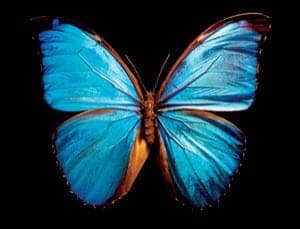Butterflies are one of the most enchanting beings in the animal kingdom, a symbol of grace and beauty encountered in every art form. From a crawling larva to a majestic winged creature, it’s difficult not to take notice of the similarities between the butterfly’s metamorphosis process and the ups and downs life serves before one may truly find himself. Before we deviate too far into the metaphysical, however, let’s take a look at what makes a butterfly truly special, namely its wings, and how science has learned to capitalize from them.

Butterfly wings, along with a peacock’s feathers, are a perfect example of structural colour display. Typically, butterfly wings contain nanostructured chitin which refracts and reflects light in such manner that it confers them the iridescent colour butterflies are known and treasured for. General Electric chemists, based at the company’s Global Research Center in Niskayuna, New York, seized this opportunity and turned these nanostructures into an infrared (IR) detector, which doesn’t require neither cooling or a heat sink.
The team of researchers lead by Radislav Potyrailo, coated the rows of tiny tree-like structures on scales, taken from a butterfly’s wings, with single walled carbon nanotubes (SWNTs) to absorb more infrared radiation. These allowed the butterfly to absorb even more heat, which caused the nano-structures to expand and in the process, altered the reflected light wavelength.
‘The chitin-based material of the Morpho tree nanostructures does absorb over the 3-8µm spectral range [the IR spectrum runs from 0.7-300µm],’ explains Potyrailo
Thermal infrared imaging currently has a myriad of applications, ranging from seeing in the dark (thermal night vision goggles) to sensors that check for insulation, however this kind of equipment is extremely complicated to build and expensive. The General Electric research infrared detector, just less then a micrometer in size, currently has a resolution 20 times sharper than existing detectors, and because of the chitin’s physical properties and its extremely small scale, it can go from cool to hot extremely fast, making it perfect for applications where fleeting changes in temperature, albeit very small (temperature drops no greater than 0.018 °C may be recorded), need to be constantly monitored.
This doesn’t mean though that we’re going to see any butterfly farms that harvest tons of butterfly wings in the near future, though. What a desolate sight that would’ve been. The GE scientists suggest other materials, such as fluoropolymers and silicones, would be far more suited for manufacturing IR imaging gear, actually outperforming the nanostructures based on the butterfly.
“We plan that the infrared light will come from one side of the bio-inspired thin film and will heat up the film,’ he says. ‘The other side of the film will be iridescent and iridescence will locally change its colours upon local heating.’
source / image


